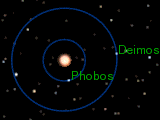 This image shows how a Black Hole may look like in the Milky Way.
This image shows how a Black Hole may look like in the Milky Way.There are three types of Black Holes – Stellar Black Holes, Supermassive Black Holes and Miniature Black Holes.


Questions may arise such as ‘How a Black Hole was discovered if it is invisible?’ and ‘Who discovered the first Black Hole?’ Here are the answers.
Before answering them let me explain about Binary Star System. A binary star system consists of two stars very close to each other and also moves around each other. Most of the stars we see in the night sky are binary stars though it looks like one twinkling star. Sirius, the brightest star in the sky is a binary star. Sirius A is bigger and brighter than Sirius B which can be seen only through a telescope. Sun, of course is a single star. Distance between two binary stars may be about 20 to 50 times the distance between Sun and Earth. But the distance between two single stars will be in Light years.

However, due to the conservation of angular momentum, the gas cannot plunge straight into the black hole, but must orbit it for some time before it gets sucked. Thus, a disc like structure is formed around the black hole from which gas is pulled slowly into the black hole. When the gas orbits the black hole in the disc, its temperature is raised to several millions of degrees which emits radiation in the X-ray part of the spectrum (by the first note that I explained above). Thus, when we detect X-ray sources in the sky, then we know that there is gas which has been heated to several million degrees, and one of the mechanisms to achieve that is the accretion disc around the black hole. Now about actual discovery: In the early 1970s, an intense X-ray source was found in the constellation Cygnus called Cygnus X-1. As the years passed, in the 1972, Cygnus X-1 was identified with a star known by its classification number HDE226868 (which is a radio source). Soon evidence was found that it is a binary star system with a period of about 5.6 days.
By the special Theory of Relativity, no information can travel faster than the speed of light. Hence, a celestial object cannot change its luminosity on a time scale shorter than the time taken for the light to reach from one side of it to the other. Analysis of Cygnus X-1 showed that its emission had luminosity variations on time scales as short as thousandths of a second, suggesting that the object was only a few kilometers wide. Thus evidence was found that one of the stars was a compact object. Finally, astronomers used the binary star system to determine the mass of the compact object and found that it was greater than the critical mass, so that it was most likely a black hole. That is about the discovery of the first black hole in our universe.














 Here is another one. This was taken from Google Earth. This object within the circle was found over california, USA. I could not guess what this object is. Google Earth replaced this area with another one and hence this cannot be found any more.
Here is another one. This was taken from Google Earth. This object within the circle was found over california, USA. I could not guess what this object is. Google Earth replaced this area with another one and hence this cannot be found any more. This certainly looks like a fake. This object, what ever it is should have been on top of a building or a pillar. All the parts below the object must have been removed through Photoshop.
This certainly looks like a fake. This object, what ever it is should have been on top of a building or a pillar. All the parts below the object must have been removed through Photoshop.  This picture is certainly a fake. Just closely look at the UFO. It looks like an object used in the mechanical workshop. It looks like the object was photographed in a close up and the two images are collaged. Moreover the shadow of the car is clearly seen. Where is the shadow of the UFO???
This picture is certainly a fake. Just closely look at the UFO. It looks like an object used in the mechanical workshop. It looks like the object was photographed in a close up and the two images are collaged. Moreover the shadow of the car is clearly seen. Where is the shadow of the UFO???
 This photo was taken at Knoxville, Tennessee, USA.
This photo was taken at Knoxville, Tennessee, USA.



















